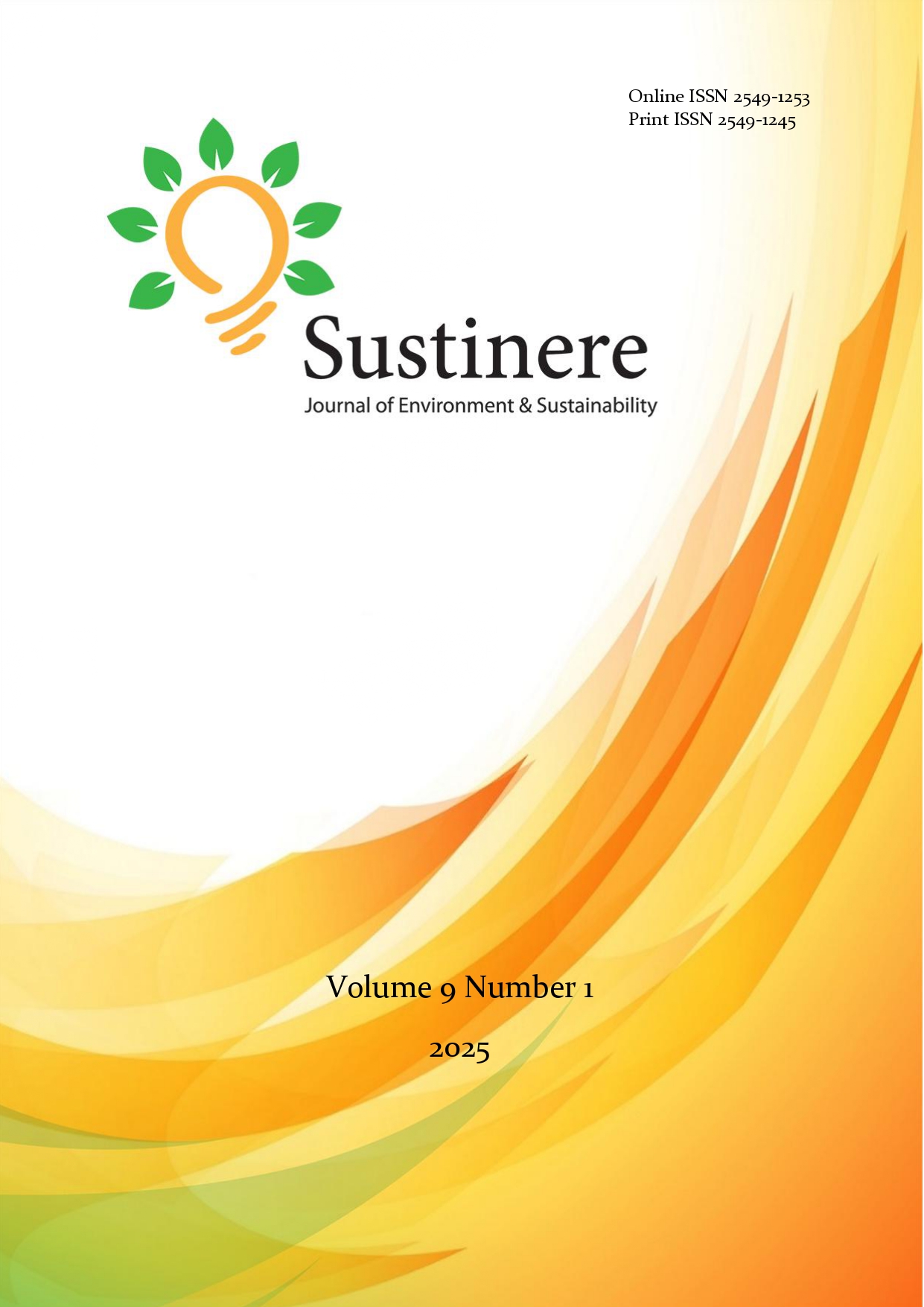Effect of ammonium/phosphate molar ratio on struvite production via electrolysis using a sacrificial magnesium anode
Main Article Content
Abstract
Excessive ammonium and phosphate levels in aquatic environments potentially cause eutrophication, leading to water quality imbalance, algal blooming, and disturbance of biodiversity status. Electrolysis using a sacrificial magnesium anode effectively removes and recovers ammonium and phosphate, producing struvite (MgNH4PO4.6H2O). The present study investigated the optimum current density and the effect of the ammonium/phosphate molar ratio on struvite production. The current density was controlled at 10, 50, and 100 mA/cm2. An artificial wastewater containing [NH4+]:[PO43-] in a molar ratio of 1:10, 1:1, and 10:1 was used as the test solution. The optimum current density was determined as 50 mA/cm2. The ammonium and phosphate reduction ratios at a 1:1 molar ratio was approximately 46.91% and 74.26%, respectively. Increasing the ammonium molarity in the test solution to 10:1 increased the phosphate reduction ratio to 96.38% while decreasing the ammonium reduction ratio to 26.28%. The maximum precipitation of 4.1914 g was generated at a molar ratio of 10:1 with a specific energy consumption of 0.011 Wh/mg-P, out of the three ammonium/phosphate molar ratio variations. Microscopes and SEM-EDS were used to characterize the precipitates produced, and Visual MINTEQ 3.1 was then used for modeling.
Article Details

This work is licensed under a Creative Commons Attribution-NonCommercial-ShareAlike 4.0 International License.
Bagastyo, A. Y., Anggrainy, A. D., Khoiruddin, K., Ursada, R., Warmadewanthi, I. D. A. A., & Wenten, I. G. (2022). Electrochemically-driven struvite recovery: Prospect and challenges for the application of magnesium sacrificial anode. Separation and Purification Technology, 288 (November 2021). https://doi.org/10.1016/j.seppur.2022.120653
Cai, Y., Han, Z., Lin, X., Du, J., Lei, Z., Ye, Z., & Zhu, J. (2022). Mechanisms of releasing magnesium ions from a magnesium anode in an electrolysis reactor with struvite precipitation. Journal of Environmental Chemical Engineering, 10(1). https://doi.org/10.1016/j.jece.2021.106661
Hug, A., & Udert, K. M. (2013). Struvite precipitation from urine with electrochemical magnesium dosage. Water Research, 47(1), 289–299. https:/doi.org/10.1016/j.watres.2012.09.036
Kékedy-Nagy, L., Teymouri, A., Herring, A. M., & Greenlee, L. F. (2020). Electrochemical removal and recovery of phosphorus as struvite in an acidic environment using pure magnesium vs. the AZ31 magnesium alloy as the anode. Chemical Engineering Journal, 380(May 2019), 1–7. https://doi.org/10.1016/j.cej.2019.122480
Kim, D., Ryu, H. D., Kim, M. S., Kim, J., & Lee, S. I. (2007). Enhancing struvite precipitation potential for ammonia nitrogen removal in municipal landfill leachate. Journal of Hazardous Materials, 146(1–2), 81–85. https://doi.org/10.1016/j.jhazmat.2006.11.054
Li, L., Bi, J., Sun, M., Wang, S., Guo, X., Li, F., Liu, J., & Zhao, Y. (2024). The Simultaneous Efficient Recovery of Ammonia Nitrogen and Phosphate Resources in the Form of Struvite: Optimization and Potential Applications for the Electrochemical Reduction of NO3−. Molecules, 29(10). https://doi.org/10.3390/molecules29102185
Lin, J. L., & Sidik, F. (2024). Harvesting of cyanobacteria and phosphorus by electrocoagulation-flocculation-flotation: Role of phosphorus precipitation in cell separations and organics destabilization. Water Research, 259(May). https://doi.org/10.1016/j.watres.2024.121868
Lin, J. L., Sidik, F., & Kang, S. F. (2023). Harvesting of microcells from cyanobacteria-laden water by energy-efficient electro-flocculation-flotation with aluminum hydrates. Journal of Water Process Engineering, 52(February), 1–9. https://doi.org/10.1016/j.jwpe.2023.103585
Luo, W., Fang, Y., Song, L., & Niu, Q. (2022). Production of struvite by magnesium anode constant voltage electrolytic crystallisation from anaerobically digested chicken manure slurry. Environmental Research, 214(July), 1–10. https://doi.org/10.1016/j.envres.2022.113991
Natsi, P. D., & Koutsoukos, P. G. (2024). Electrochemical Recovery of N and P from Municipal Wastewater. Crystals, 14(8). https://doi.org/10.3390/cryst14080675
Siciliano, A., Limonti, C., Curcio, G. M., & Molinari, R. (2020). Advances in struvite precipitation technologies for nutrients removal and recovery from aqueous waste and wastewater. Sustainability (Switzerland), 12(18). https://doi.org/10.3390/su12187538
Silva-Gálvez, A. L., López-Sánchez, A., Camargo-Valero, M. A., Prosenc, F., González-López, M. E., & Gradilla-Hernández, M. S. (2024). Strategies for livestock wastewater treatment and optimised nutrient recovery using microalgal-based technologies. Journal of Environmental Management, 354(January). https://doi.org/10.1016/j.jenvman.2024.120258
Vaishnav, S., Saini, T., Chauhan, A., Gaur, G. K., Tiwari, R., Dutt, T., & Tarafdar, A. (2023). Livestock and poultry farm wastewater treatment and its valorization for generating value-added products: Recent updates and way forward. Bioresource Technology, 382(May). https://doi.org/10.1016/j.biortech.2023.129170
Wang, L., Gu, K., Zhang, Y., Sun, J., Gu, Z., Zhao, B., & Hu, C. (2022). Enhanced struvite generation and separation by magnesium anode electrolysis coupled with cathode electrodeposition. Science of the Total Environment, 804. https://doi.org/10.1016/j.scitotenv.2021.150101
Ye, Y., Ngo, H. H., Guo, W., Liu, Y., Chang, S. W., Nguyen, D. D., Liang, H., & Wang, J. (2018). A critical review on ammonium recovery from wastewater for sustainable wastewater management. Bioresource Technology, 268(June), 749–758. https://doi.org/10.1016/j.biortech.2018.07.111
Zheng, X. Y., Kong, H. N., Wu, D. Y., Wang, C., Li, Y., & Ye, H. R. (2009). Phosphate removal from source separated urine by electrocoagulation using iron plate electrodes. Water Science and Technology, 60(11), 2929–2938. https://doi.org/10.2166/wst.2009.309

